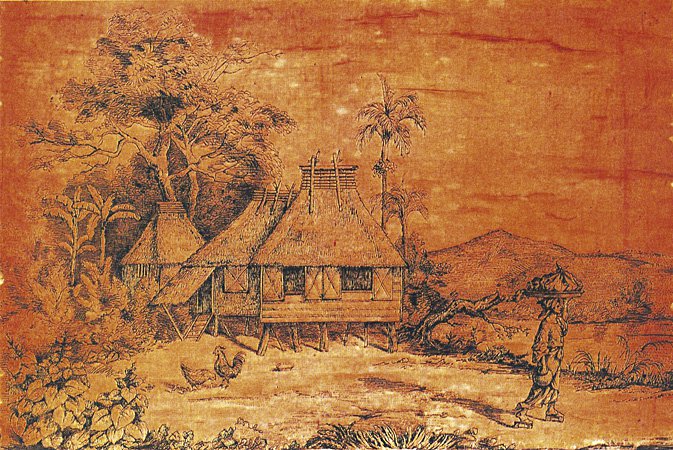Cultural Center of the Philippines
ENCYCLOPEDIA OF
PHILIPPINE ART
[Country Scene]
Ca 1880s / Human hair on silk fabric / 28 x 43 cm / Artist: Adelaida Paterno / Bangko Sentral ng Pilipinas Collection
In Country Scene, a woman is shown on her way to the market, wearing a camisa (sheer top paired with an undershirt), a skirt, wooden slippers or bakya, with a bilao (round woven tray) on her head. The woman is actively working and not merely passively posing. She is shown walking away from the picture plane, but remains the main focus of the scene. Behind her are three nipa huts with their windows and doors open. The huts are typical—with steep roofs and elevated from ground level. In front of the huts are two chickens and their brood. Several coconut and guava trees surround the nipa huts. The roof and fences, and even the leaves, are done in detail. On the background is a mountain. Our line of vision is equally drawn to the structures, landscape, and the woman walking. This is a clear attempt by Adelaida Paterno (1880-1962) to show the spaces of working women in the 19th century, from the perspective of an ilustrada (educated) artist. It is clear that Adelaida sees the working women’s space as expansive, especially when compared to her own narrow space as ilustrada. The working woman is more active and more mobile, and has more freedom.
Country Scene exemplifies the level of skill in embroidery using human hair on Chinese silk achieved during the 19th century. It is possible that Adelaida used her own hair for this work. The artist’s dedication to detail, in this example of paisaje (landscape) and genre, is obvious. Adelaida’s decision to use human hair to depict a laboriously detailed landscape and figures is admirable, considering that she had no formal art training.
Adelaida has four extant works: one landscape and genre painting and three landscape and genre embroidered with human hair on Chinese silk. The influence of her older sister, Paz Paterno, on her paisaje and genre painting is seen in the combination of genres. However, the use of embroidery with hair is unique to Adelaida. Adelaida’s style is different from that of Paz, particularly because Adelaida does not idealize her subjects. Her works are more realistic in their rendering of dilapidated fences and nipa huts. The shores, the boats, and the working women are not romanticized, and therefore hew closer to the “roughness” of the reality of life among the laboring classes.
In conventional art-historical accounts, embroidery is not considered a “legitimate” art form but a leisurely activity. Most mainstream writers would compare Adelaida’s embroidery to a drawing to render it more legitimate. However, when viewed from broader perspective of art and cultural history, Country Scene is a legitimate artwork that may be studied as a construct of societal conditions, gender differentiations, and power relations at the time of its creation.
Written by Eloisa May P. Hernandez
